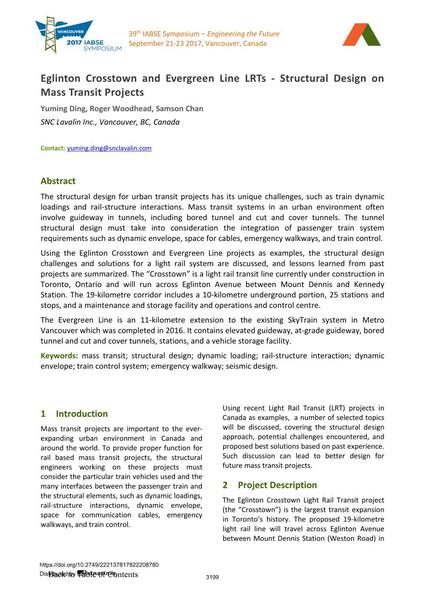Eglinton Crosstown and Evergreen Line LRTs - Structural Design on Mass Transit Projects

|
|
|||||||||||
Bibliographic Details
| Author(s): |
Yuming Ding
(SNC Lavalin Inc., Vancouver, BC, Canada)
Roger Woodhead (SNC Lavalin Inc., Vancouver, BC, Canada) Samson Chan (SNC Lavalin Inc., Vancouver, BC, Canada) |
||||
|---|---|---|---|---|---|
| Medium: | conference paper | ||||
| Language(s): | English | ||||
| Conference: | IABSE Symposium: Engineering the Future, Vancouver, Canada, 21-23 September 2017 | ||||
| Published in: | IABSE Symposium Vancouver 2017 | ||||
|
|||||
| Page(s): | 3199-3205 | ||||
| Total no. of pages: | 7 | ||||
| Year: | 2017 | ||||
| DOI: | 10.2749/222137817822208780 | ||||
| Abstract: |
The structural design for urban transit projects has its unique challenges, such as train dynamic loadings and rail-structure interactions. Mass transit systems in an urban environment often involve guideway in tunnels, including bored tunnel and cut and cover tunnels. The tunnel structural design must take into consideration the integration of passenger train system requirements such as dynamic envelope, space for cables, emergency walkways, and train control. Using the Eglinton Crosstown and Evergreen Line projects as examples, the structural design challenges and solutions for a light rail system are discussed, and lessons learned from past projects are summarized. The “Crosstown” is a light rail transit line currently under construction in Toronto, Ontario and will run across Eglinton Avenue between Mount Dennis and Kennedy Station. The 19-kilometre corridor includes a 10-kilometre underground portion, 25 stations and stops, and a maintenance and storage facility and operations and control centre. The Evergreen Line is an 11-kilometre extension to the existing SkyTrain system in Metro Vancouver which was completed in 2016. It contains elevated guideway, at-grade guideway, bored tunnel and cut and cover tunnels, stations, and a vehicle storage facility. |
||||
| Keywords: |
structural design seismic design dynamic loading mass transit emergency walkway rail-structure interaction dynamic envelope train control system
|
||||
